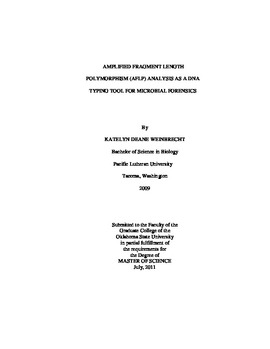| dc.contributor.author | Weinbrecht, Katelyn Deane | |
| dc.date.accessioned | 2014-04-17T20:11:58Z | |
| dc.date.available | 2014-04-17T20:11:58Z | |
| dc.date.issued | 2011-07-01 | |
| dc.identifier.uri | https://hdl.handle.net/11244/10311 | |
| dc.description.abstract | The objective of this research was to adapt and refine a published method for DNA profiling of microbial strains such that it can be used to attribute a plant pathogen recovered as evidence in a biocrime to a source. Amplified Fragment Length Polymorphism (AFLP) profiles were prepared from a variety of Pseudomonas strains pathogenic for plants, humans or both. Included among the species examined were 10 strains of <italic>Pseudomonas syringae</italic> pv. maculicola, and 4 stains of <italic>Pseudomanas aeruginosa</italic>. AFLP profiles were produced and analyzed using capillary electrophoresis with an ABI310 Genetic Analyzer. AFLP profiles were reduced to a numeric haplotype code that conveyed the size characteristics of the AFLP profiles of the different isolates from the different strains and species. Haplotype codes could then be compared and utilized to distinguish the different strains. The AFLP assay in this study exhibited over 97% reproducibility through three replicate analyses performed on each strain. Visual comparison of the electropherograms and use of a numerical haplotype code identifying each strain showed every analyzed strain of <italic>P. syringae</italic> pv. maculicola and <italic>P. aeruginosa</italic> to be unique. Discriminatory power was also assessed across pathovars with comparison to 8 strains of <italic>P. syringae</italic> pv. tomato, and across species with comparison to 8 strains of <italic>Serratia marcescens</italic> and 7 strains of <italic>Staphylococcus aureus</italic>. The discriminatory power of the AFLP assay was further established through pairwise similarity analysis and agglomerative hierarchical clustering analysis of all strains. AFLP analysis performed on three cultures of <italic>P. aeruginosa</italic> PAO1 obtained from three separate laboratories showed that AFLP analysis can detect genetic mutations that accumulate in a single bacterial strain during culturing over many years. Haplotype code discrepancies observed among replicate runs of a strain or among multiple cultures of a strain were minor, with less than 5% of the entire haplotype code being affected in each incident. Haplotype codes were organized into an AFLP database created with the ability to enter the haplotype code of an unknown strain into a query that will search the database for a match. The creation and expansion of an AFLP database allows AFLP analysis to be applied in a broader forensic context. Results of this study determine that AFLP technology is sufficiently reproducible, powerful, and reliable for use as a molecular screening tool in microbial forensics. | |
| dc.format | application/pdf | |
| dc.language | en_US | |
| dc.publisher | Oklahoma State University | |
| dc.rights | Copyright is held by the author who has granted the Oklahoma State University Library the non-exclusive right to share this material in its institutional repository. Contact Digital Library Services at lib-dls@okstate.edu or 405-744-9161 for the permission policy on the use, reproduction or distribution of this material. | |
| dc.title | Amplified Fragment Length Polymorphism (AFLP) Analysis as a DNA Typing Tool for Microbial Forensics | |
| dc.type | text | |
| osu.filename | Weinbrecht_okstate_0664M_11570.pdf | |
| osu.college | Center for Health Sciences | |
| osu.accesstype | Open Access | |
| dc.description.department | School of Forensic Sciences | |
| dc.type.genre | Thesis | |
| dc.subject.keywords | amplified fragment length polymorphism | |
| dc.subject.keywords | bioterrorism | |
| dc.subject.keywords | microbial forensics | |
| dc.subject.keywords | pseudomonas syringae | |
